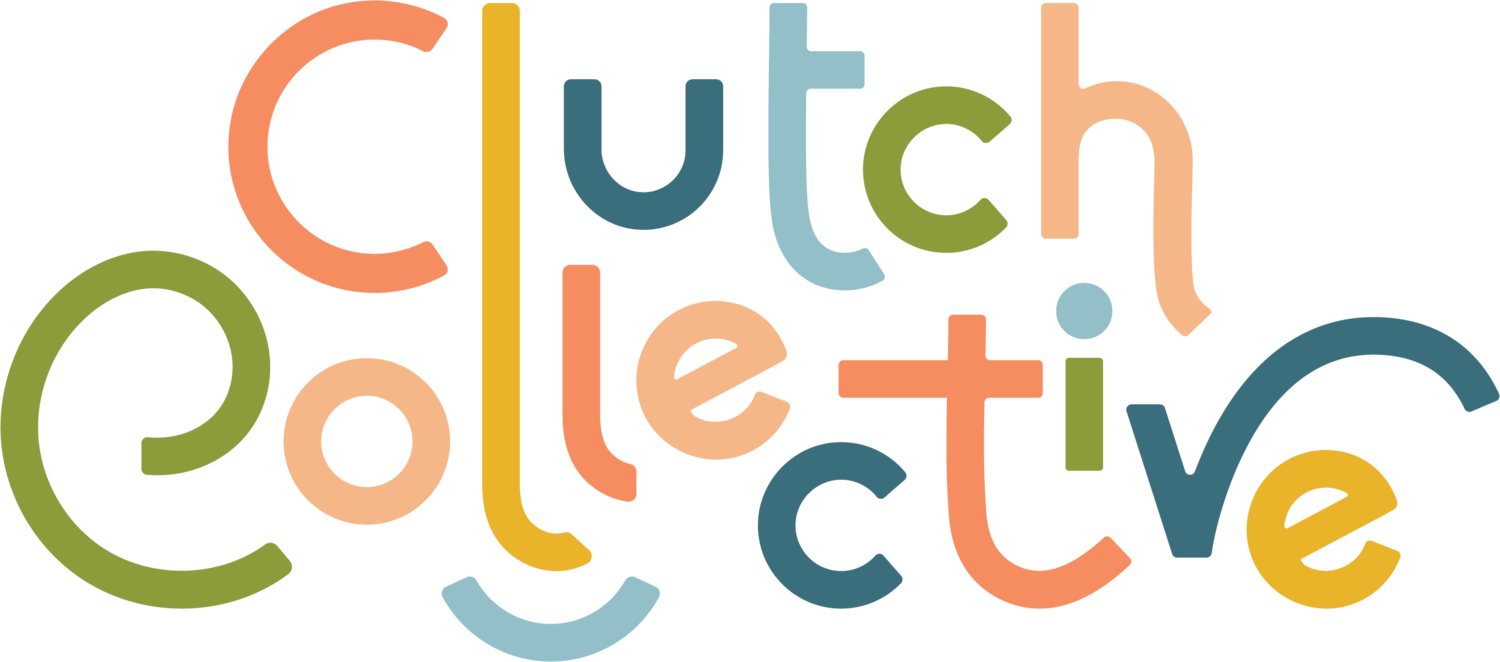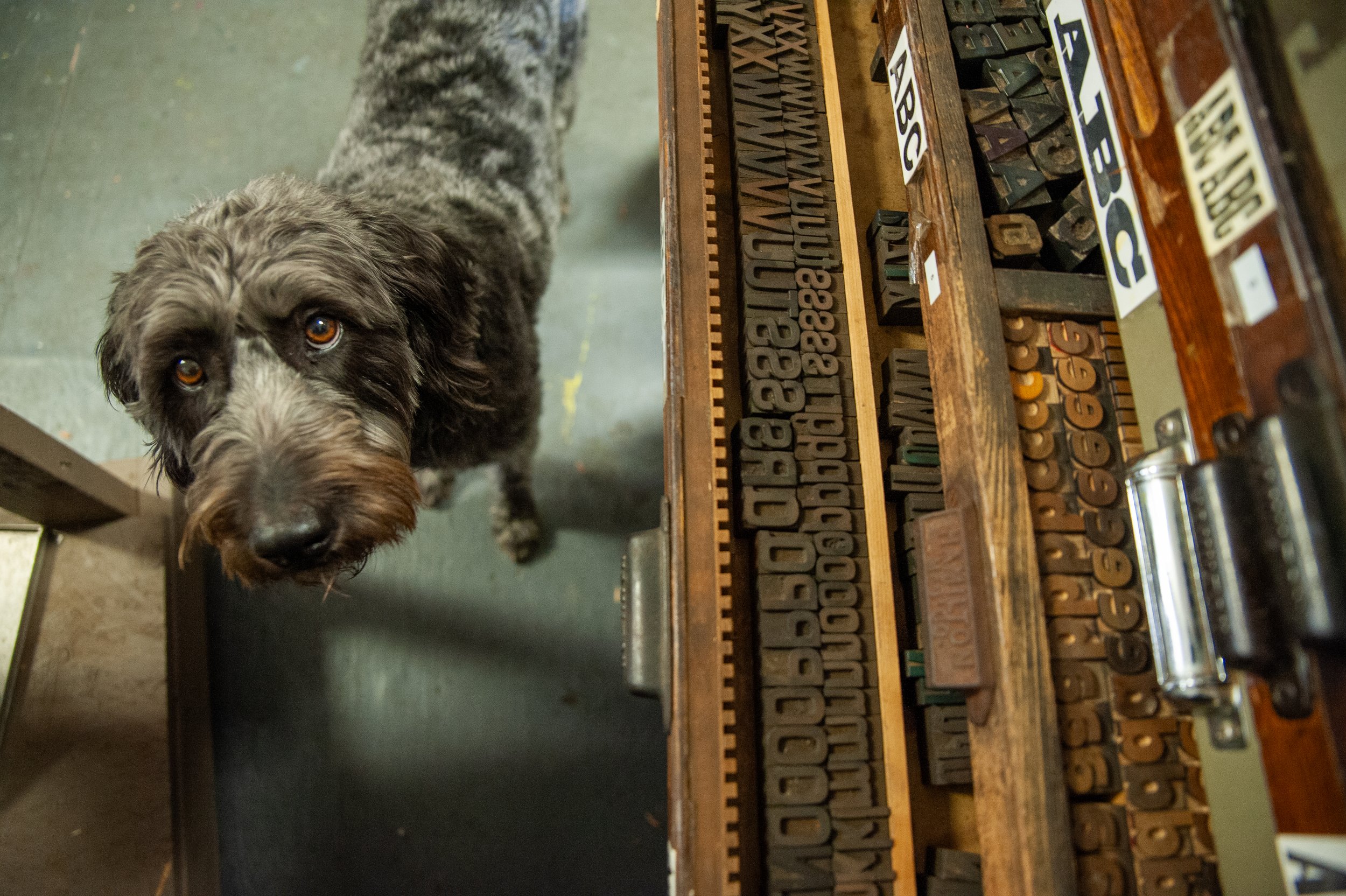Art & Business: An Interview with Bobby Rosenstock
JustAJar Design Press is a graphic design & letterpress studio run by husband-and-wife team Sara and Bobby Rosenstock. The studio + storefront is a well-loved fixture in downtown Marietta, just as Sara and Bobby are beloved members of both the artist community and our local community. The studio specializes in custom woodcut and letterpress posters, manually printed from hand-carved wood blocks and hand-set type on their antique printing presses. Globally recognized, JustAJar has created iconic show posters for the likes of John Prine, Billy Strings, Caamp, Willie Nelson, Tyler Childers, and Lucinda Williams, and commissioned work for clients like Jack Daniels. The studio was recently highlighted in “Carving Blocks: Printmakers & Their Stories,” a published collection of 23 block printers from around the world.
Sara and Bobby balance one another as business partners. A trained artist, Bobby transfers hand sketches to plywood for carving, then creates prints using the hand-carved blocks. In addition to teaching graphic design at Marietta College, Sara co-runs the studio and uses her technical skills to apply the designs to a variety of products, packaging, websites, and more.
Bobby has been making woodcut prints since 2003 and working in letterpress since 2007. In 2009, he and Sara moved to Marietta from Philadelphia. He found an old Vandercook printing press, set it up in their garage, and started making art under the name JustAJar Design Press. Around that time, he also created an Etsy page and began to sell work online and through traveling to participate in art and craft fairs (which he highly recommends as a great way to learn about selling and interacting with customers and meet other artists.)
After fifteen years as a full-time artist, Bobby has learned a thing or two about the art of running an art business. We asked Bobby to talk with us about wearing both hats, dealing with burnout, finding inspiration, and maintaining a healthy balance.
Did you always approach your art as a business or was there a moment when the switch flipped and you realized you’d need to wear both hats? How have you navigated wearing both hats?
I spent a few years after college in Portland, Oregon trying to figure out how I would make a living as an artist. I tried selling my art in galleries and that never really felt right. My day job was working in a large commercial print shop, which I really enjoyed but it felt too big, and I hated the amount of waste that came out of the industry. I was searching for something in between the fine art and commercial print worlds. When we moved to Philadelphia, I discovered letterpress printing and immediately fell in love, it was exactly what I was looking for. Where I am now is somewhere between commercial and fine art. I work with clients, but I have the creative freedom to explore ideas I’m interested in. One of the things I love about printmaking is that it is an affordable art form, so it’s accessible to everyone.
Have you experienced burnout - as a small business owner, an artist, or both? What do you do when that happens – how do you push through?
Burnout is something that all artists experience. Making art involves spending a lot of time alone in your head, it can be physically and emotionally draining. It also involves putting yourself in a vulnerable place, by sharing things you create with the public. When something you make sells or gets positive feedback online it feels great, but when a design gets rejected or doesn't get the sales or response you were hoping it sucks, and it's hard not to take it personally. Every artist at every level has experienced the highs and especially the lows. You learn to grow a thick skin, but when an arrow gets through it hurts more when you pull it out.
Every artist compares themselves to what they see on Instagram, and while it can be inspiring it can also make you feel inferior. We all want to be better, sell more, and get more followers and likes. It’s all relative though, no matter what stage you’re at, you can beat yourself up about not being good enough, but we should be focusing on where we’re at and how far we’ve come. It's easier said than done, but I often try to think about what my 18-year-old self would think about the art I'm making today, and I know he'd be super psyched.
I make art every day, and a few times a year I hit a wall in which I become completely burnt out. This can range from just being tired or uninspired or can escalate to feelings of imposter syndrome or depression. I've been riding the rollercoaster for long enough now that I tell myself that I'll make it out of the rut just like I did last time. But it's still hard. As I've gotten older my body doesn't bounce back like it used to. Carving wood and printing is very physical, my body always hurts. Self-care is important. I started seeing a chiropractor and getting regular massages. I try to eat healthy, do yoga, and run, but I've never been great at routine exercise, so I just try to do my best. During my slow season, I have to remind myself it's ok to take a day off occasionally, to go for a walk in the woods, read a book, or binge some TV to recharge.
With such a large body of work, how do you draw inspiration for new pieces? How do you keep things fresh?
I try to be present and absorb my surroundings. I’m thinking about my work when I’m driving, showering, trying to fall asleep, watching TV, or playing with my kids. My sketchbooks are filled with little ideas; an evocative sentence I read in a novel, something I saw on TV, an interesting animal I came across while watching TikTok videos, something I heard on the radio, etc. I have a few themes and concepts I explore often. I love creating work that tells a story. I really enjoy experimenting with little things, like pattern, texture, and color. It’s important to challenge yourself and push outside of your comfort zone. I also try to find other creative outlets outside of the art that pays my bills. Art should be fun. Playing banjo and being involved with Marietta Main Street’s Public Art Committee has filled those roles for me. I also love making art with my kids, I learn so much from watching them.
How do you keep tabs on and manage your growth so that you don’t scale too large for comfort? Was that a difficult decision to make?
I always knew I wanted to keep my business small; right now, it’s Sara and I and one very part-time employee. I’ve seen friends who’ve had small businesses grow and who seem to spend more time managing and less time creating and are stressed all the time. I’ve always wanted to keep things as simple as possible. Our capitalist culture encourages businesses to grow and make more money. And it can be tricky to keep things small, a business can be like a snowball rolling down a hill, getting bigger as it goes. As your business grows you get more and bigger clients reaching out, and you reach a point where you either need to hire help or turn down projects. It can be hard to do that, but I try to focus on the things I want to do and keep it small and simple.
Do you feel as though you have reached an ideal balance between your art, the business side of things, and your personal life? What advice would you offer others who might be struggling to find a balance or feel like its too much to juggle?
The juggling act is constant. I used to be able to work all day and night on my art. Once we had kids, I started working a 9-5 in the shop. I still spend many evenings drawing or working on business stuff on the computer, but I want to spend as much time with my kids while they still like hanging out with me. I also try to save time each year to work on personal art projects. The juggling act is a little different for everyone depending on your lifestyle and situation, you’ve got to work and pay the bills, but you also must take care of yourself and the people around you. It might change from year to year, but you just have to follow what feels right and tweak it as you go.
You can learn more about Bobby’s process and see more of JustAJar’s work on their website, Facebook page, and Instagram!
All photography by the amazing Michelle Waters Photo







